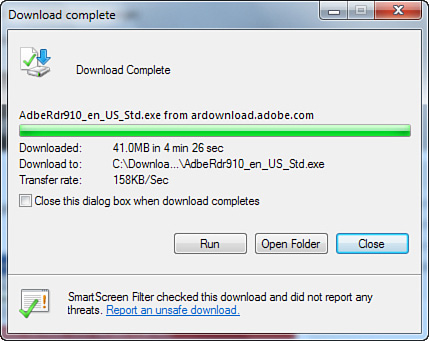3. Downloading Programs
Although
the Web is most often thought of as a source of information and
entertainment, it is also an excellent—and often only—place to obtain
new software or updates for existing programs.
You can find numerous excellent resources for downloading free or trial versions of software. Good sources are www.tucows.com and http://download.cnet.com/windows/.
Follow the specific instructions for installation provided by the
software publisher (and offered on most download sites), but when
you’re downloading, these general rules apply:
- Some
websites require you to choose from a number of “mirror sites” for your
download. Mirror sites are servers in different parts of the world that
have the same files on them. The redundancy prevents traffic jams on a
single server when many people access it for the same program
downloads. You are asked to select a location that is geographically
close to you, but you’re usually free to choose any site you want. The
closer ones are sometimes faster, but not always. Sometimes I get
quicker downloads from a mirror site in another country whose citizens
are likely sleeping.
- To begin the download, typically
you click a link that says something similar to “Download Now.” This
should open a dialog box asking you if you want to open or save the
file. Choose to save. Select a location that you will remember for
saving the download files—it is a good idea to create a Downloads
folder. Within the Downloads folder, I create a new subfolder with the
name of the program and then switch to that folder and save the program
there. This way, all my downloads are organized.
- At
the office, check with your network administrator before you install
any new software to find out what your company policies are. In fact,
if you are in a corporate environment, you probably won’t be able to
install new programs unless you are one of the lucky few with
Administrator privileges. Most corporations limit users installing
software, for obvious security reasons.
- Scan all
downloads with virus-scanning software before you install them. Pay
particular attention to archives and ISO image files, which are often
carriers of software viruses regardless of whether or not the software
comes from legitimate channels (though there’s less likelihood than
with peer-to-peer and free hosting sites).
- Many
downloads come in a compressed ZIP format. If you download such a file,
you can run it easily in Windows 7 because ZIP files are supported
without needing to install a ZIP program such
as WinZip or TurboZIP. Just double-click the ZIP file, and it will open
in a folder window. Then examine the contents. You probably need to
double-click the installer or Setup program to begin installing the
program into Windows 7.
Tip
Downloads
are fastest when Internet traffic is low, such as late at night. If you
are given a choice of mirror sites for a download, keep in mind the
local time for each site and choose a server located where current
traffic is likely to be lower. |
During
the download process, a window appears showing the download progress
and the estimated time remaining. The estimates are helpful, but thanks
to fluctuating transfer speeds, these estimates also can be extremely
unreliable. You might want to watch the window for a moment to see if
the estimate changes in your favor. If you can’t wait that long, click
Cancel and try again later.
Tip
Create
a Software folder in your Favorites list, and add to it the
manufacturers’ websites for software you own. Doing so will make it
easier to periodically check for updates. |
In
addition to downloading new software, you can download updates to
software you already own. Check the manufacturer’s website occasionally
to see whether new updates, patches, or bug fixes are available (this
is especially important for entertainment software).
4. Protecting Against Bad Downloaded Programs
IE
helps protect your computer from potentially malicious software. When
you use IE to download a file, a message might appear in the
information bar just below the Address box saying this:
To
help protect your security, Internet Explorer blocked this site from
downloading files to your computer. Click here for options.
Clicking the information bar opens a drop-down list of options (see Figure 1).

If
you choose to allow the page to download a program, you’ll see another
dialog box warning you about downloaded programs and asking whether you
want to run the program from its remote location across the Web or save
it to your hard disk, as shown in Figure 2.

If you choose to run the program from the site rather than save it, you’ll likely see the dialog box shown in Figure 3.
All executable files that are downloaded are checked for publisher
information using a scheme called Authenticode. Authenticode checks the
digital signature of the file against a database of known good software
publishers, and gives you some advice about the file. After being
presented with the information, you can make a more informed decision
about running the file.

Some
program publishers have been “black listed,” and Windows 7 prevents
them from running in your PC under Windows 7. Executable files with
blocked publishers are not allowed to run.